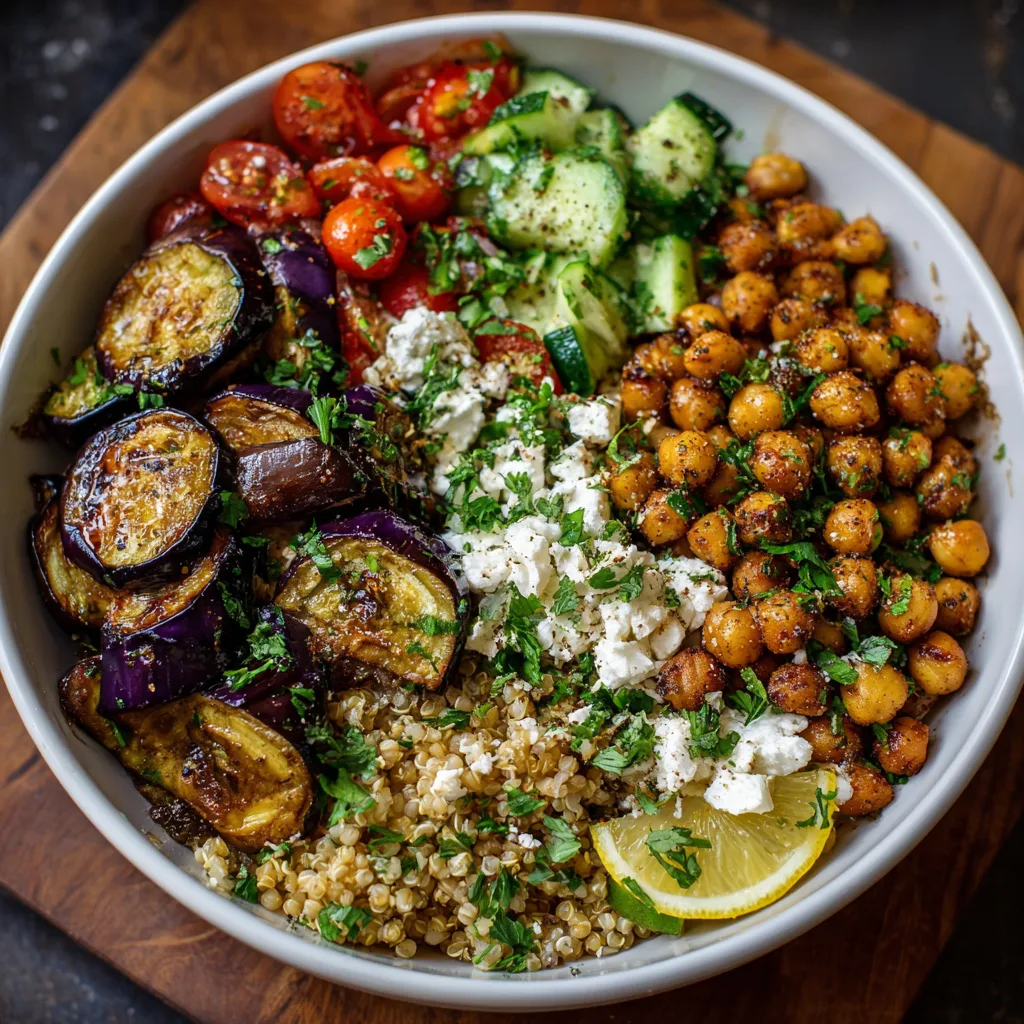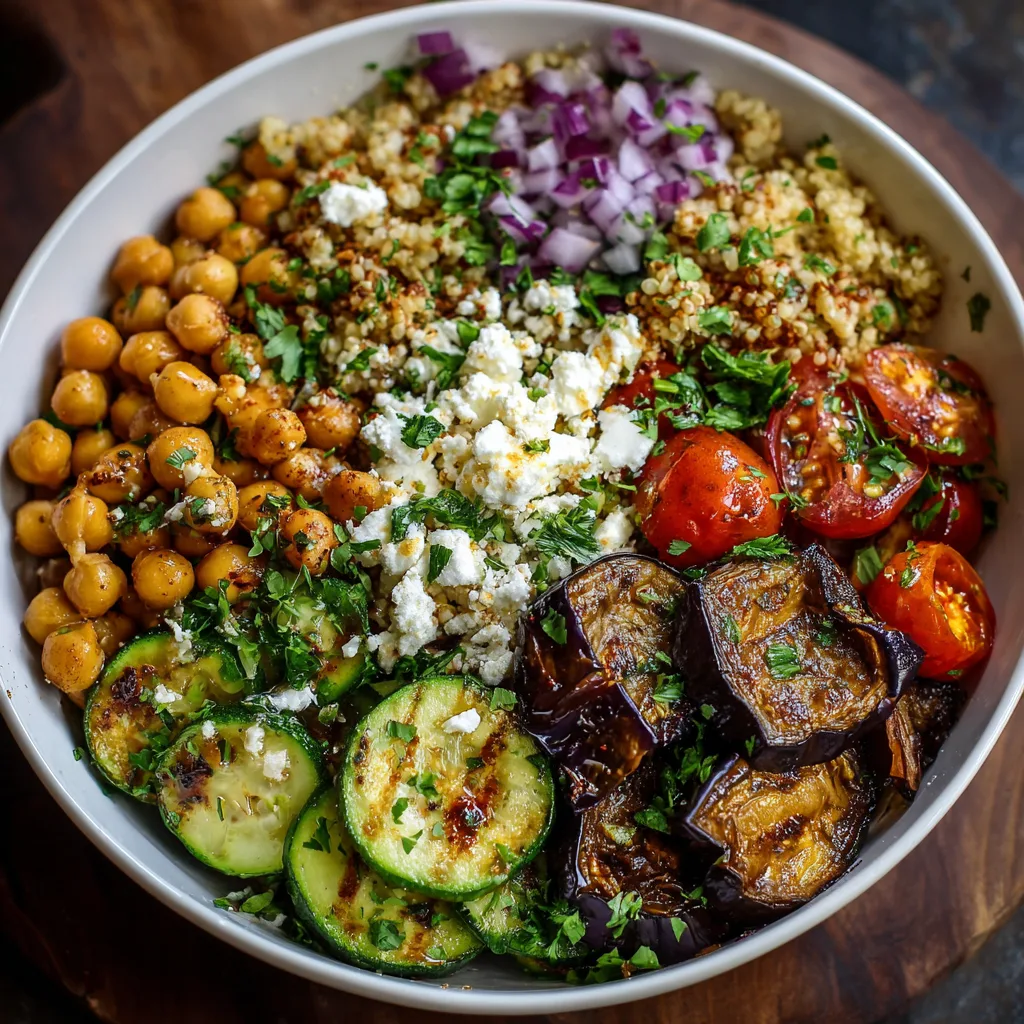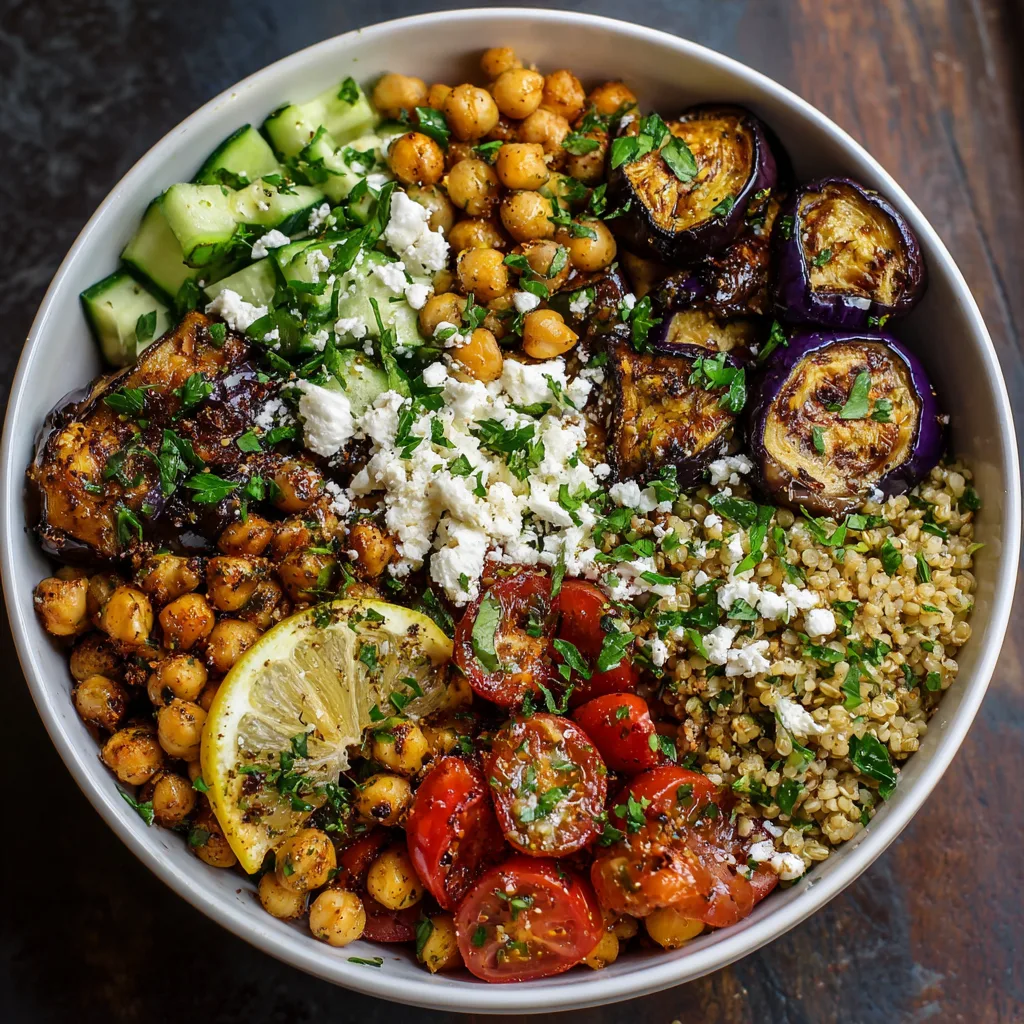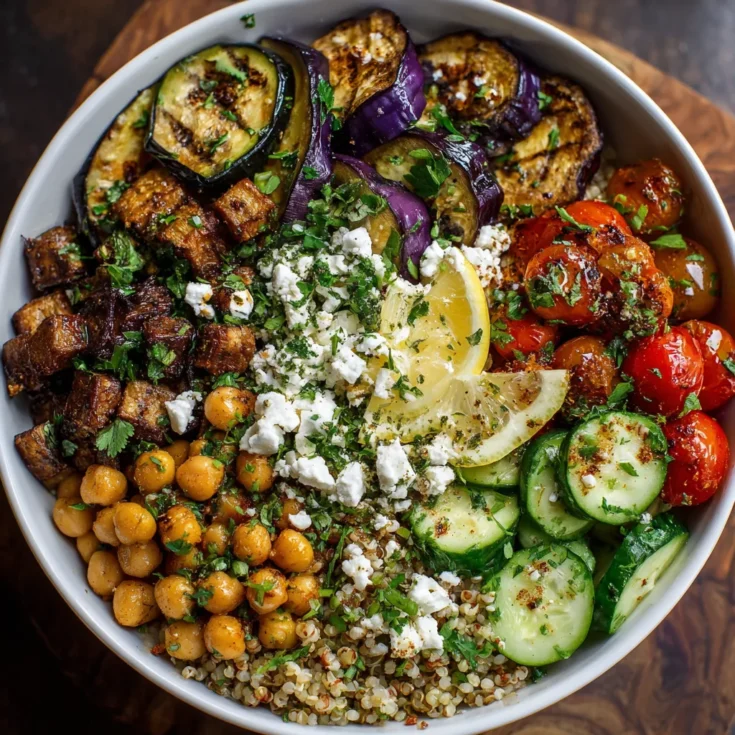High Protein Mediterranean Eggplant Grain Bowl
A High Protein Mediterranean Eggplant Grain Bowl is a vibrant, nutrient-packed dish. It combines tender roasted eggplant with wholesome grains and protein-rich ingredients. This bowl blends fresh Mediterranean flavors with a satisfying boost of protein, perfect for anyone seeking a balanced, delicious meal.
Why Choose a Mediterranean Eggplant Grain Bowl?
The Mediterranean diet emphasizes fresh vegetables, whole grains, and healthy fats, supporting heart health and longevity. Eggplant stands out with its rich antioxidants and fiber, aiding digestion and reducing inflammation. Paired with grains like quinoa or bulgur and protein sources like legumes, this bowl offers a well-rounded meal that fuels your body. This wholesome combination makes it an excellent choice for a nutritious, flavorful lunch or dinner.
The High-Protein Angle: Balancing Vegetables and Plant-Based Protein
To make this dish truly high in protein, focus on smart ingredient choices. Quinoa delivers complete protein, containing all essential amino acids. Adding legumes such as chickpeas or lentils increases protein and fiber, creating lasting energy. Incorporate seeds like pumpkin or sunflower for extra crunch and nutrients. Including cheese like halloumi or a soft-boiled egg boosts protein further and adds creaminess. This thoughtful balance transforms simple vegetables into a satisfying, protein-packed bowl that supports muscle health and keeps hunger at bay.
Eggplant: Flavor, Texture, and Nutrition
Eggplant offers a unique, slightly sweet flavor with a creamy texture when cooked properly. Its spongy flesh soaks up flavors, making it ideal for roasting or sautéing. Roasting eggplant enhances its natural sweetness and gives it a tender, melt-in-your-mouth quality. Sautéing delivers a quicker cook but may retain a firmer bite. Nutritionally, eggplant is low in calories and packed with fiber, antioxidants, and vitamins such as B1 and potassium. Its antioxidants, including nasunin, support brain health and fight oxidative stress. When selecting eggplants, choose firm, glossy skins with no blemishes for the best taste and texture. Proper preparation, like salting before cooking, helps reduce bitterness and excess moisture. These qualities make eggplant a delicious and nutritious base for any Mediterranean grain bowl.
Whole Grains & Plant Proteins: Nutrient Powerhouses
Whole grains like quinoa, farro, bulgur, and barley serve as excellent foundations for a protein-rich Mediterranean bowl. Quinoa stands out as a complete protein, containing all nine essential amino acids, making it especially valuable in plant-based diets. Farro and barley provide hearty textures with substantial fiber and protein, though they are not complete proteins on their own. Bulgur offers a nutty flavor and cooks quickly, ideal for busy meal prep. Each grain delivers complex carbohydrates that sustain energy levels while aiding digestion. Combining grains with legumes or seeds ensures a balanced amino acid profile and improves overall protein quality. Choosing these whole grains boosts the meal’s fiber, vitamins, and minerals, aligning perfectly with Mediterranean nutrition principles.
Legumes, Cheese & Eggs for a Protein Boost
Chickpeas, halloumi cheese, and soft-boiled eggs bring a significant protein boost to Mediterranean grain bowls. Chickpeas add both protein and fiber, supporting muscle repair and digestive health. Halloumi, a firm cheese, grills well and adds savory richness and extra protein. Including soft-boiled eggs introduces a creamy texture along with high-quality protein and essential nutrients like vitamin D and choline. This combination draws inspiration from traditional dishes such as the sabich bowl, where eggplant pairs harmoniously with eggs and tahini. These protein sources not only enhance the bowl’s nutritional profile but also improve satiety and flavor complexity.
Flavor Components & Healthy Fats
To elevate flavor and nutrition, include healthy fats like extra-virgin olive oil and tahini. Fresh herbs, such as parsley and dill, add brightness and aroma. Creamy yogurt dressings provide tanginess and probiotics, while olives and capers contribute bursts of salty, briny flavor. These components work together to create a well-rounded, satisfying bowl that supports heart health and enhances the Mediterranean taste experience.
Mediterranean Veggie Grain Bowl – Roasted Eggplant, Chickpeas, and Quinoa
One popular variation of the Mediterranean grain bowl features roasted eggplant, chickpeas, and quinoa. Inspired by recipes from One Hungry Bunny and Simply Quinoa, this bowl combines tender, caramelized eggplant with protein-packed quinoa and nutty chickpeas. Roasting the eggplant intensifies its flavor and softens its texture, making each bite satisfying. Quinoa adds a fluffy, slightly crunchy element that complements the roasted veggies. This combination delivers a complete protein profile thanks to quinoa’s essential amino acids and chickpeas’ fiber-rich punch. The bowl often includes fresh herbs like parsley, a drizzle of lemon juice, and a sprinkle of toasted seeds to enhance taste and nutrition. EatingWell and The Kitchn emphasize this bowl as a versatile, nutrient-dense meal perfect for lunch or dinner. Adding a light tahini or yogurt-based dressing ties all the flavors together, creating a balanced, wholesome dish.
Buddha-Style Bowls: Bulgur or Barley with Roasted Vegetables and Tahini Dressing
Buddha-style bowls have gained popularity for their vibrant colors and nourishing ingredients. Gastroplant offers a bulgur pilaf meal prep combining chewy bulgur with roasted Mediterranean vegetables like eggplant, zucchini, and bell peppers. Bulgur provides a nutty flavor and excellent fiber content, though it is not a complete protein alone. To add protein and richness, many bowls feature a drizzle of tahini dressing made from ground sesame seeds, which brings healthy fats and a creamy texture. Another variation uses barley mixed with pistachios and raisins, adding crunch and sweetness, as highlighted by Dishing Out Health. These bowls balance flavors with fresh herbs such as mint and parsley, and lemon juice adds brightness. The Big Man’s World® emphasizes how these meals support easy meal prep while delivering on flavor and nutrition. The combination of grains, roasted vegetables, nuts, and tahini creates a satisfying, well-rounded meal.
Eggplant + Halloumi + Farro or Grain with Yogurt Sauce Variant
This variation centers on pairing roasted eggplant with grilled halloumi cheese and farro or other whole grains. Dishing Out Health presents a popular version where creamy lemon-dill yogurt sauce brings a refreshing contrast to the salty halloumi and smoky eggplant. Farro lends a chewy texture and hearty base, complementing the rich cheese and vegetables. The yogurt sauce adds tang and moisture, enhancing the Mediterranean flavor profile. This bowl offers a well-balanced protein boost from halloumi and grains while remaining vibrant and colorful. The mix of textures — soft eggplant, chewy farro, and crispy cheese edges — creates an inviting eating experience that satisfies both taste buds and nutritional needs.
High-Protein Sabich Bowl Variant
The sabich bowl is a traditional Israeli-inspired dish featuring fried or roasted eggplant, chickpeas, and soft-boiled eggs, making it naturally high in protein. Mark Hyman, MD, highlights a version packing approximately 30 grams of protein per serving. Tahini sauce enriches the bowl with healthy fats and creaminess. This variant includes layers of smoky eggplant, tender chickpeas, and perfectly cooked eggs to provide sustained energy and muscle support. Fresh herbs, pickled vegetables, and a squeeze of lemon elevate the flavor while maintaining Mediterranean authenticity. This high-protein sabich bowl satisfies hunger and supports a balanced diet, making it an excellent option for those seeking plant-forward but protein-rich meals.





